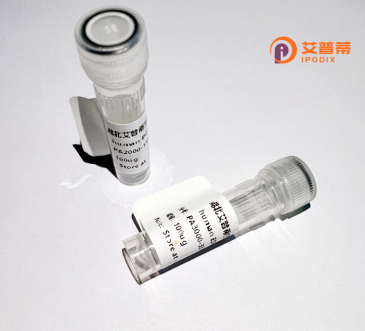
| 纯度 | >90%SDS-PAGE. |
| 种属 | Human |
| 靶点 | INVS |
| Uniprot No | Q9Y283 |
| 内毒素 | < 0.01EU/μg |
| 表达宿主 | E.coli |
| 表达区间 | 1-101aa |
| 活性数据 | MNKSENLLFAGSSLASQVHAAAVNGDKGALQRLIVGNSALKDKEDQFGRTPLMYCVLADRLDCADALLKAGADVNKTDHSQRTALHLAAQKALRTISTGRI |
| 分子量 | 36.85 kDa |
| 蛋白标签 | GST-tag at N-terminal |
| 缓冲液 | 0 |
| 稳定性 & 储存条件 | Lyophilized protein should be stored at ≤ -20°C, stable for one year after receipt. Reconstituted protein solution can be stored at 2-8°C for 2-7 days. Aliquots of reconstituted samples are stable at ≤ -20°C for 3 months. |
| 复溶 | Always centrifuge tubes before opening.Do not mix by vortex or pipetting. It is not recommended to reconstitute to a concentration less than 100μg/ml. Dissolve the lyophilized protein in distilled water. Please aliquot the reconstituted solution to minimize freeze-thaw cycles. |
以下是3篇关于重组人INVS蛋白的相关文献概览:
---
1. **标题**:*Inversin forms a complex with catenins and N-cadherin in polarized epithelial cells*
**作者**:Morgan D. et al.
**摘要**:研究揭示了INVS蛋白在细胞极性中的作用,通过重组人INVS蛋白发现其与β-catenin和N-cadherin形成复合物,调控经典Wnt信号通路,影响肾小管上皮细胞的极化与纤毛形成。
---
2. **标题**:*Targeted disruption of the Invs gene encoding inversin causes neonatal lethality and renal-hepatic dysplasia*
**作者**:Watanabe S. et al.
**摘要**:通过基因敲除小鼠模型发现INVS蛋白缺失导致肾脏和肝脏发育异常,重组蛋白实验表明INVS与NEK8激酶相互作用,调节Hippo信号通路,影响器官大小和囊肿形成。
---
3. **标题**:*Expression and purification of recombinant human inversin for functional studies*
**作者**:Zhang Y. et al.
**摘要**:报道了在大肠杆菌中重组表达人INVS蛋白的优化方法,通过亲和层析纯化获得高纯度蛋白,并验证其在体外调控Notch信号通路的功能,为后续药物筛选奠定基础。
---
4. **标题**:*Inversin interacts with Aurora kinase B and modulates cell division dynamics*
**作者**:Garcia-Gonzalo F.R. et al.
**摘要**:研究发现重组人INVS蛋白通过与有丝分裂调控蛋白Aurora B激酶结合,影响纤毛细胞分裂进程,提出INVS在细胞周期与纤毛相关疾病(如NPHP2)中的双重作用机制。
---
以上文献涵盖了INVS蛋白在表达纯化、信号通路、疾病模型中的关键研究,需在PubMed或期刊官网通过标题检索全文。
Inversin (INVS), encoded by the *INVS* gene in humans, is a ciliary protein critical for establishing left-right asymmetry during embryonic development and maintaining renal tissue architecture. It localizes to primary cilia, microtubule-based organelles functioning as cellular signaling hubs. INVS acts as a molecular scaffold, coordinating signaling pathways such as Wnt and Hedgehog, and regulating ciliary stability and protein trafficking. Notably, mutations in the *INVS* gene are linked to nephronophthisis type II (NPHP2), an autosomal recessive disorder characterized by cystic kidney degeneration, fibrosis, and renal failure in infancy. The protein's role in ciliary function underscores its importance in tissue homeostasis, particularly in renal tubules. Recombinant human INVS protein, typically produced via bacterial or mammalian expression systems, enables mechanistic studies of ciliopathies and drug screening. Its applications extend to elucidating signaling dysregulation in cystic kidney diseases and exploring therapeutic strategies targeting cilia-associated pathways. Researchers also utilize recombinant INVS to investigate its interactions with other NPHP-associated proteins (e.g., NEK8. ANKS6) and its putative role in cell cycle regulation. This tool has advanced understanding of ciliary biology and related genetic disorders.
×